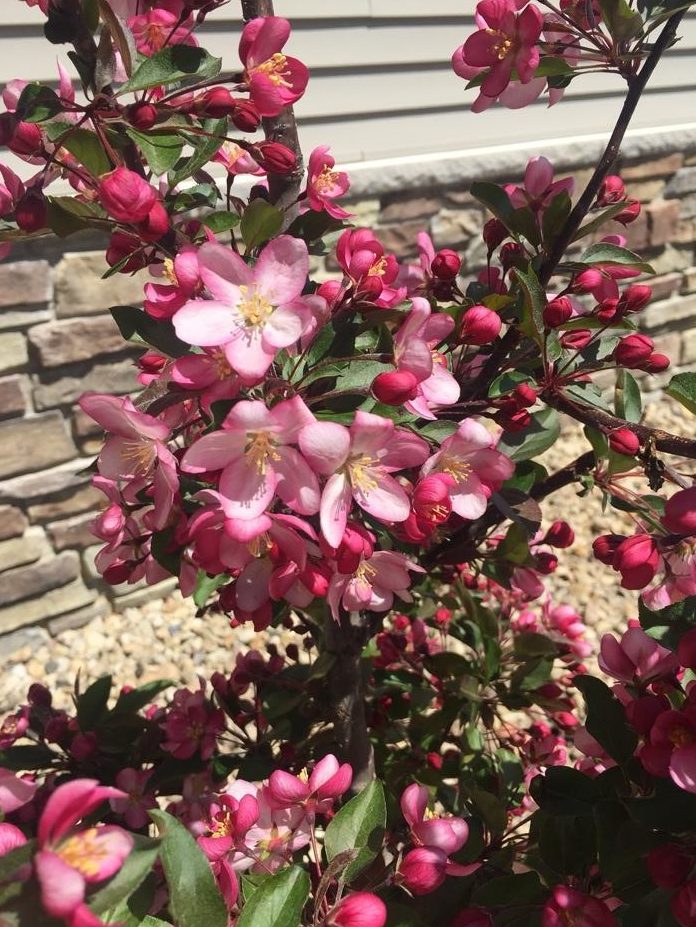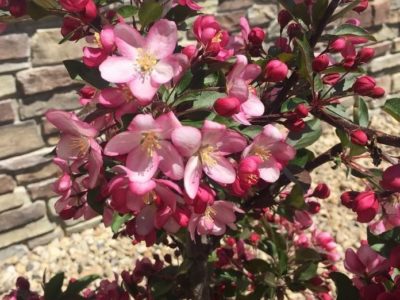By Matthew Olson
Late Spring is a time of year when many flowering plants are at their best. The bulbs are still putting on a show, and the early perennials are at their peak bloom. Flowering trees give structure to a landscape, while providing stunning color. These trees are also known as ornamental trees. Ornamental trees are primarily grown for their flowers. They work well in smaller landscapes because they tend to be smaller than shade trees. Shade trees are typically larger in size and provide ample amounts of shade. We’ll be looking at some common and unique types of flowering trees that grow well in the upper Midwest.

When people think of Magnolias, they often picture Southern Magnolias that are commonly grown in the southern U.S. But there are several types of magnolias that will grow well in Minnesota. Magnolias grow best in sites that have some protection from strong winds. They shouldn’t be planted in areas with a strong southern exposure because the flower buds on Magnolias are sensitive to spring freezes. Southern exposures tend to be warmer and lead to earlier flowering, resulting in increased risk for freeze damage. A common variety of magnolia that is grown in this region is the ‘Royal Star’ Magnolia, which features large white double flowers that are fragrant. ‘Royal Star’ grows to be about 8-12 ft tall. Another favorite of mine is the ‘Jane’ Magnolia, which blooms slightly later than ‘Royal Star’ and has large pink flowers. This variety also grows to be 8-12 ft tall. If you’re looking for a larger magnolia, the variety ‘Merrill’ is a great option, attaining a height of 20-30 ft tall, with white flowers. The bloom time for magnolias is typically late April-Mid May in the Twin Cities region.

One of my favorite flowering trees is the Northern Redbud. The Redbud features small pink flowers that densely cover the branches, and even the trunk of the tree at times! In Minnesota, this tree does best in sites that are slightly protected. They can handle full sun- part shade, and typically grow 20-30 ft tall. In the wild, Redbuds are often found growing in the understory of forests. If you choose to grow a Redbud, it’s recommended that you purchase them from a local nursery, and not a big box store. The main reason is because many Redbuds found at big box stores are not fully hardy in Minnesota because they were grown in southern nurseries. The Minnesota Landscape Arboretum has developed a strain of Redbud, called the ‘Minnesota Strain’ that is hardier for this region. Local nurseries typically use this strain for their Redbud production, allowing for hardier trees. Redbuds usually flower around the same time as Magnolias.
The next type of tree we’ll look at is the Crabapple. Crabapples are very common, and you’ve likely seen them in bloom this time of year. In my opinion, the best aspect of this tree is the variety of shapes, sizes and flower color that you can grow. Crabapples are primarily grown for their spring flower display. The most common flower colors are pink, red and white. Some varieties also have purple and red foliage. Crabapple varieties come in numerous shapes, such as weeping, rounded and spreading. If you have limited space, a good choice is the variety ‘Tina’, which only grows 6-8 ft tall. There are other dwarf varieties as well. Most crabapples range from 6-25 ft tall and wide. Some varieties of crabapple are prone to various disease problems, making it important to choose varieties that have good disease resistance.
When I was growing up, my family and I would go to Mississippi every spring break to visit my grandma. During one of our visits, I noticed a small tree near her driveway that was covered in white fringe-like flowers. The flowers looked so delicate, and I assumed this tree was something that couldn’t grow in the upper Midwest, but it turns out I was wrong. The tree that I saw was a Fringe tree. Fringe trees are native to the Eastern U.S., and feature unique white flowers that bloom in late spring. This tree typically grows 12-20 ft and is slow to leaf out. Like the Redbud, this tree should be bought from a local nursery to ensure the tree is locally produced and hardy.

The common Lilac is very popular throughout Minnesota, with its purple fragrant blooms and durability. But there’s other types of Lilacs that thrive here as well. Lilacs are typically grown as shrubs, but some lilacs can be grown as trees. The Dwarf Korean Lilac is commonly found in a tree form. This type of lilac features fragrant pink blossoms that bloom about 1-2 weeks later than the Common Lilac. The growth habit of this tree is rounded and looks formal. Korean Lilacs generally grow only 6-8 ft tall, making this a great choice for small spaces. If you’re looking for a Lilac with a natural tree shape, the Japanese tree Lilac is a great choice. These small trees grow 15-25 ft tall and feature fragrant white flowers that bloom about a month after the common Lilac. Japanese Tree Lilacs often have multiple stems and a dense growth habit.
The next tree we’ll look at is the Serviceberry. Serviceberries are native to Minnesota and feature small white flowers that cover the tree in mid-late spring. They also produce sweet edible fruit that mature in summer. They reach 20-25 ft tall and grow well in sites with moist soil that drains well. Serviceberries usually have an upright growth habit with multiple stems. The most common variety of serviceberry is ‘Autumn Brilliance’, which features bright red foliage in fall, along with the showy spring flowers. While most serviceberries have multiple stems, there is a new variety of Serviceberry called ‘Spring Flurry’ that has only a single stem, giving it a more typical tree appearance.
Most trees in Minnesota flower in spring or summer, but there is one native tree that flowers in late Fall after all the leaves have fallen. The American Witch hazel is a small tree that mainly grows in understory areas of the forest. They can tolerate a good amount of shade and grow 15-20 ft tall and wide. The flowers are small, yellow and have a unique ribbon shape. Witch hazels are not a very common tree in the landscape, but they should be planted more. They’re very hardy and durable. It should be noted that only the American Witch Hazel (Hamamelis virginiana) blooms in Fall. There are other species of Witch Hazel, and they bloom in early spring, usually in March.
Flowering trees are an excellent way to bring structure to your garden, even if you don’t have much space. This is the perfect time of year to see many of these trees in bloom. I hope these ideas will inspire you to try growing some of these trees in the future. Happy Gardening!
Photo sources- HGTV.com, Winter Blooms
Plants.ces.ncsu.edu, Chionanthus virginicus
For more advice like this, visit our Blog Page. If you are looking into gardening services around Minnetonka, Wayzata, Excelsior, or related areas, Contact Us Today!

